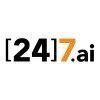


i
Blue Yonder
Filter interviews by
Blue Yonder Interview Questions, Process, and Tips
Blue Yonder Interview Experiences
62 interviews found
I applied via Campus Placement and was interviewed in Jun 2024. There were 3 interview rounds.
Data Structures and Algorithms medium level questions
(2 Questions)
- Q1. I was asked to solve problems from linkedlist and trees. Then he asked about concepts of OOPs and DBMS. Comparatively he asked tough questions from OOPs.
- Q2. As I had used reactjs, nodejs and MongoDB in my project, interviewer asked FAQs from these topics.
(2 Questions)
- Q1. How do you handle pressure.
- Q2. Toughest problem faced in project.
- Ans.
Implementing a real-time chat feature with message encryption and decryption.
Implementing end-to-end encryption to ensure secure communication
Handling real-time updates and synchronization across multiple devices
Dealing with potential performance issues due to encryption and decryption processes
Associate Software Engineer Interview Questions asked at other Companies
I was interviewed in Sep 2024.
(1 Question)
- Q1. 2 simple dsa questions and asked about javascript and react questions
(1 Question)
- Q1. Asked react advance concepts and one machiene coding round
Interview Preparation Tips
React Js Frontend Developer Interview Questions asked at other Companies
I applied via Campus Placement and was interviewed in Nov 2024. There were 3 interview rounds.
Time and work,speed , logical reasoning
(2 Questions)
- Q1. About projects done
- Q2. Why are you choosing this company
(2 Questions)
- Q1. Basic C program
- Q2. Diode working, DSA concept
Product Engineer Interview Questions asked at other Companies
(2 Questions)
- Q1. Explain even loop
- Q2. Explain how redux works
Top Blue Yonder Senior Software Engineer Interview Questions and Answers
Senior Software Engineer Interview Questions asked at other Companies
Blue Yonder interview questions for popular designations
(2 Questions)
- Q1. React native related questions
- Q2. Experince in developing mobile apps
- Ans.
I have 3 years of experience developing mobile apps for both iOS and Android platforms.
Developed mobile apps using Swift for iOS and Java/Kotlin for Android
Experience with mobile app design principles and user interface development
Worked on integrating APIs and third-party libraries for enhanced functionality
(1 Question)
- Q1. Generic interview
Skills evaluated in this interview
Software Engineer Interview Questions asked at other Companies
Get interview-ready with Top Blue Yonder Interview Questions
(1 Question)
- Q1. Explain any one ML model to a non tech stakeholder?
- Ans.
Random Forest is a machine learning model that uses multiple decision trees to make predictions.
Random Forest is an ensemble learning method that combines multiple decision trees to improve accuracy and reduce overfitting.
Each decision tree in the Random Forest is trained on a random subset of the data and features.
The final prediction is made by averaging the predictions of all the individual trees in the forest.
Rando...
Data Science Consultant Interview Questions asked at other Companies
Jobs at Blue Yonder
I was interviewed in Aug 2024.
(2 Questions)
- Q1. Explain back propagation?
- Ans.
Back propagation is a technique used in neural networks to update the weights of the network by calculating the gradient of the loss function with respect to the weights.
Back propagation involves calculating the error at the output layer and then propagating it back through the network to update the weights using gradient descent.
It uses the chain rule of calculus to calculate the gradient of the loss function with res...
- Q2. Explain batch normalization?
- Ans.
Batch normalization is a technique used in machine learning to improve the training of deep neural networks by normalizing the input of each layer.
Batch normalization normalizes the input of each layer by adjusting and scaling the activations.
It helps in reducing internal covariate shift, which leads to faster convergence during training.
Batch normalization also acts as a regularizer, reducing the need for other regula...
(2 Questions)
- Q1. Explain transformer architechure?
- Ans.
Transformer architecture is a type of deep learning model that uses self-attention mechanism to process sequential data.
Utilizes self-attention mechanism to weigh the importance of different input elements
Consists of encoder and decoder layers for processing input and generating output
Introduced in the paper 'Attention is All You Need' by Vaswani et al. in 2017
- Q2. How back propagation overtime works?
- Ans.
Back propagation over time is a method used in recurrent neural networks to update weights by propagating errors backwards through time.
Back propagation through time (BPTT) is an extension of the backpropagation algorithm for recurrent neural networks.
It involves unfolding the network over time and calculating gradients for each time step.
The gradients are then used to update the weights of the network to minimize the ...
Senior Data Scientist Interview Questions asked at other Companies
(1 Question)
- Q1. Java, streams,coding
Interview Preparation Tips
and then came reverse a LinkedList question, so i took couple minutes and presented solution, initially he didn't say anything, and then he said my solution is wrong, so i went through the code and an example as well, still not able find the flaw, then he said conditions while loop is not right, again i thoroughly checked not able find error, i asked why it is wrong and tried explained my code as well, but he is not trying understand and conducting interview as if interrogation and not uttering a word as if he revealing something, in-between he is saying its simple question, and he is typing something, seeing and comparing, finally i said ok, i don't know and assume i am wrong lets move next question, as i am losing time, he did similar stuff following questions, later i checked in google and finally realized that he is checking geekforgeeks code and comparing my code, first of all a question can have multiple solutions and later run my code it works the same, but he comparing loop to loop and variable to variable, saying my code is wrong, i tried to explain he does not even understand how to reverse linked list and saying very easy question and treating like interrogation, so disappointed.
Software Engineer Interview Questions asked at other Companies
(2 Questions)
- Q1. Java Basics like jdk, jre, core java questions
- Q2. Merge sort
Top Blue Yonder Senior Software Engineer Interview Questions and Answers
Senior Software Engineer Interview Questions asked at other Companies
(1 Question)
- Q1. Explain microservices architecture.
- Ans.
Microservices architecture is an architectural style that structures an application as a collection of loosely coupled services.
Each service is self-contained and can be developed, deployed, and scaled independently.
Services communicate with each other over lightweight protocols like HTTP or messaging queues.
Microservices allow for better scalability, flexibility, and resilience compared to monolithic architectures.
Exa...
Skills evaluated in this interview
Senior Staff System Engineer Interview Questions asked at other Companies
(2 Questions)
- Q1. Basics of oops concepts,testing concepts,SQL
- Q2. Make your introduction strong
- Ans.
I am a highly skilled Technical Consultant with a proven track record of successfully implementing complex solutions for clients.
Highlight key technical skills and experience
Mention specific projects or achievements
Emphasize problem-solving abilities and client satisfaction
(2 Questions)
- Q1. Situation on how to manage a team crucial times
- Q2. How to go along with employees having diffrence of opinion
- Ans.
Listen to their perspectives, encourage open communication, find common ground, and work towards a compromise.
Encourage open communication to understand each employee's perspective
Listen actively and show empathy towards their opinions
Find common ground and areas of agreement to build upon
Work towards a compromise that addresses the concerns of all parties involved
Interview Preparation Tips
Technical Consultant Interview Questions asked at other Companies
Top trending discussions







Blue Yonder Interview FAQs
The duration of Blue Yonder interview process can vary, but typically it takes about less than 2 weeks to complete.
Recently Viewed
Tell us how to improve this page.
Blue Yonder Interviews By Designations
- Blue Yonder Senior Software Engineer Interview Questions
- Blue Yonder Software Engineer Interview Questions
- Blue Yonder Lead Software Engineer Interview Questions
- Blue Yonder Support Engineer Interview Questions
- Blue Yonder Associate Software Engineer Interview Questions
- Blue Yonder Support Engineer 1 Interview Questions
- Blue Yonder Technical Support Engineer Interview Questions
- Blue Yonder Business Consultant Interview Questions
- Show more
Interview Questions for Popular Designations
Blue Yonder Interview Process
based on 61 interviews
Interview experience
Interview Questions from Similar Companies
Fast track your campus placements
Blue Yonder Reviews and Ratings
based on 533 reviews
Rating in categories
|
Senior Software Engineer
364
salaries
| ₹0 L/yr - ₹0 L/yr |
|
Technical Consultant
261
salaries
| ₹0 L/yr - ₹0 L/yr |
|
Software Engineer
232
salaries
| ₹0 L/yr - ₹0 L/yr |
|
Senior Technical Consultant
191
salaries
| ₹0 L/yr - ₹0 L/yr |
|
Senior Business Consultant
178
salaries
| ₹0 L/yr - ₹0 L/yr |

SAP

Manhattan Associates

Oracle

Infor Global Solution
- Home >
- Interviews >
- Blue Yonder Interview Questions














